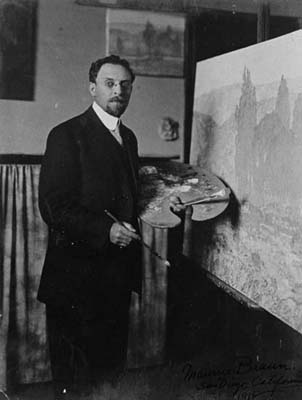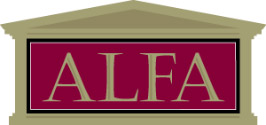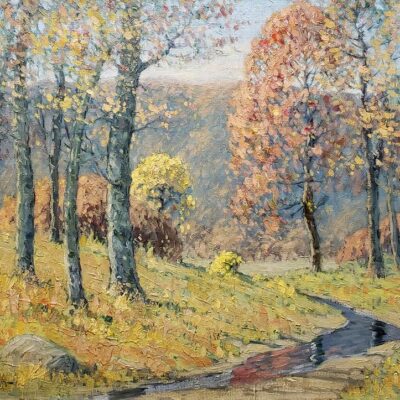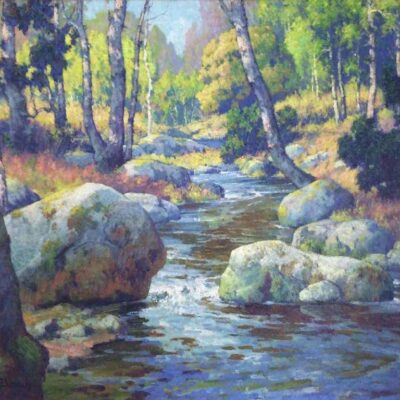Maurice Braun (1877-1941)
Biography

Maurice Braun was born on October 1, 1877 in Nagy-Bittse (Nagybiccse), Hungary, which, after World War I, became part of northwestern Slovakia and renamed Bytca. His parents were Ferdinand Braun and Charlotte Leimdofer. When Braun was four years old, he moved with his family to New York City and was already showing an exuberance for copying and drawing pictures. In his youth, he frequently visited the Metropolitan Museum of Art where he would spend hours copying from the masters. At the age of fourteen, he apprenticed with a jeweler, however, his real passion was to create paintings.
In 1897, at the age of twenty, Braun enrolled at the National Academy of Design in New York City to study fine art and continued at the Academy for five years, studying under Francis Coates Jones (1857-1932) and George Willoughby Maynard (1843-1923). After which, he spent one year studying with William Merritt Chase (1849-1916) at the New York School of Art, formerly Chase School of Art, located at 106-108 East 23rd Street in New York City. From 1902 to 1903 Braun traveled to Europe to study art in museums and galleries, mainly in Berlin, Vienna, and Hungary. Upon return, he focused on portrait and figure work.
While an art student Braun became acquainted with the Theosophical movement, a spiritual philosophy founded in 1875 in New York City that advocated world peace and an appreciation for the art and philosophy of ancient and various cultures. After the death of its founder, Helena Blavatsky, the movement was reorganized under Madame Katherine Tingley as the Theosophical Society in America and established a community in San Diego called Lomaland. Although establishing himself in New York as a figure and portrait artist, Braun decided to move to California in 1909 and open a studio, which was initially in downtown San Diego in a building owned by the Theosophical Society. Eventually, he built his own studio and home on Point Loma in San Diego that overlooked the bay and was in close proximity to the Theosophical community.
Braun was entranced by Southern California’s vivid light and abundant natural surroundings. Through his paintings of San Diego’s backcountry and coastal regions, he recorded a time that was peaceful, devoid of tract houses and shopping centers. His paintings are defined in a delicate manner and express a meditational quality. In the 1954 exhibition of paintings by Maurice Braun at the M. H. de Young Memorial Museum in San Francisco, the accompanying catalog includes an essay written by art historian John F. Kienitz, in which he stated: "Maurice Braun's serenity before the vexations of life and the complexities of nature impressed all who knew him. He was an artist of deep philosophical conviction for whom all expressions of life were divine. So, it is natural that in the look and feel of his work you should find pastoral peace. This peace is born of his sense of wholeness.”
Maurice Braun became a significant leader in the San Diego art community which included a robust group of artists, such as Charles Reiffel, Charles A. Fries, Leon Bonnet, Reginal Machell, and Elliot Torrey. In 1912 Braun founded the San Diego Art Academy at his studio on B Street where he served as director, and in 1915 he co-founded the San Diego Art Guild. In addition to maintaining a studio in San Diego, Braun also kept a studio in Silvermine, Connecticut from 1922 to 1924, before returning permanently to San Diego. In 1929 he became a co-founder of Contemporary Artists in San Diego.
Braun’s paintings of idyllic California landscapes garnered him national attention and numerous awards. He was presented with the Hallgarten prize from the National Academy of Design (1900) and Gold Medals from the Panama-California Exposition in San Diego (1915, 1916). His paintings were displayed in many prominent exhibitions including the National Academy of Design (1911-1915), Carnegie Institute (1911-1915), Pennsylvania Academy of Fine Art (1911), Panama Pacific International Exposition (1915), Art Institute of Chicago, Golden Gate International Exposition (1939), and solo exhibitions at the Los Angeles County Museum of History, Science, and Art (1918 and 1920). In 2013, a painting by Maurice Braun, California Splendor, was purchased at Bonhams Auction House in Los Angeles for $188,500. Additionally, Braun was active in several professional art organizations, including Laguna Beach Art Association, Salmagundi Club (New York City), Ten Painters Club (Los Angeles), Painters of the West, and in 1912 he joined the California Art Club with whom he exhibited regularly for the next twenty years.
Maurice Braun married Hazel Boyer on January 30, 1919. They had two children, Charlotte Leclère Braun and Ernest Boyer Braun. In a 2001 interview for The Journal of San Diego History, Charlotte and Ernest described their father’s work as that of a “Plein-Air artist, a trend that suggests that he painted exclusively outdoor.” They continued, “As with these early artists, the outdoor sketch was a study. From these studies, there may or may not have ultimately come a painting. Both painting and sketching outdoors [were] enjoyable for him, but certainly not routine. When sketching, he used color pencils on paper and sometimes oil paint on canvas or board. We remember one time, when he was recovering from an illness, the family stayed for a week or two in a cottage at Mesa Grande. Here we recall seeing him walking off to a site he had located earlier carrying a canvas, easel, and a box containing a palette and tubes of paint. Sometimes there was a folding camping chair as well, although often he stood before the canvas for hours.”
Braun’s paintings, particularly those of San Diego’s backcountry, are expressed in loose brush and a harmonious palette of high-keyed color subdued in soft layers of haze. The result is a compositional balance of space, color, and light that interprets the essence of the land in all its mystery. In the 1991 exhibition catalog for Masterworks of American Impressionism presented at the Villa Favorita in Lugano, Switzerland and included work by Maurice Braun, art historian William H. Gerdts, Ph.D., quoted Braun as remarking, "Landscape should not be taken too literally. It is what we visualize and the interpretation we give the fantasy of our mind that counts.”
Maurice Braun passed away on November 7, 1941 in his beloved town of San Diego, California.
Elaine Adams
Director
American Legacy Fine Arts
Research Sources:
The Artist Maurice Braun: Aesthetic and Philosophic Values by Charlotte Braun White and Ernest Boyer Braun, published in “The Journal of San Diego History”, Summer 2001, Volume 47, Number 3
What Distinguishes San Diego Landscape to Painters by Thomas Larson, San Diego Reader, August 26, 1999
Second Nature: Four Early San Diego Landscape Painters by Martin E. Petersen, published 1991
AskART


